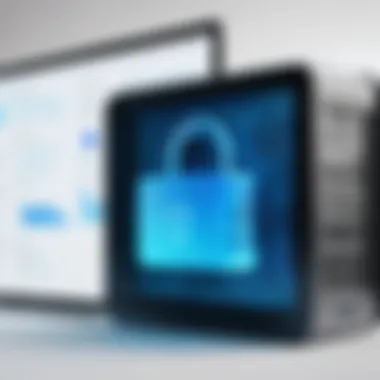Comprehensive Review of Secure Hospice Software


Intro
The world of hospice care is marked by its intimate and sensitive nature. As such, the tools that assist care providers play a pivotal role in ensuring the delivery of compassionate and efficient services. With the rise of technology in this field, secure hospice software solutions are becoming increasingly important. These solutions not only help in managing patient data but also in fulfilling compliance requirements while maintaining a high standard of care. Their importance cannot be overstated, considering they contribute to both the operational efficiency and security of sensitive information.
In this article, we delve deeply into the features and capabilities of secure hospice software. Through a comprehensive analysis, we will explore how these tools enhance the daily operations of hospice care providers, making it easier for teams to focus on what truly matters — providing dignified care for patients in their final stages of life.
Understanding Hospice Software
In the realm of healthcare, particularly in the field of hospice care, the significance of understanding hospice software cannot be overstated. This type of software serves as a backbone to the operational efficiency of care providers. It simplifies processes, enhances communication, and ensures that all essential data is easily accessible at the fingertips of healthcare professionals.
Delving into hospice software requires a keen awareness of its multiple functionalities. Not only does it manage day-to-day operations, but it also ensures compliance with industry regulations, particularly regarding patient care and data protection. Additionally, as more organizations adopt digital solutions, recognizing the distinct types of hospice software available becomes paramount. This section will discuss several key areas including its definition, major types, and the vital importance of security within these systems.
Definition and Purpose
Hospice software essentially refers to the digital tools designed to streamline operations within hospice organizations. The primary purpose is to provide efficient management of patient care, from intake to billing and follow-up. These systems enable caregivers to focus more on providing quality end-of-life care rather than getting bogged down in administrative tasks. For instance, they can schedule appointments, track treatment plans, and maintain communication with families seamlessly, ensuring that no patient feels overlooked.
Types of Hospice Software
To understand hospice software better, it's crucial to explore its various types. Each type has its unique roles and functionalities that cater to the different needs of hospice providers.
Patient Management Systems
A significant component of hospice software is patient management systems. These systems facilitate the organization of patient data, scheduling, and care plans. One of the standout characteristics of these systems is their ability to consolidate all pertinent patient information in one place. This is particularly beneficial as it ensures that medical staff can quickly access and update patient records whenever necessary. A unique feature offered by many of these systems is the ability to integrate with mobile applications. This allows caregivers to receive real-time updates when they’re on the go. However, it is worth noting that the dependence on technology can be a two-edged sword; if the system goes down, healthcare professionals can face significant delays.
Billing and Insurance Processing
Billing and insurance processing is another vital aspect of hospice software. This software helps organizations navigate the often complex world of healthcare reimbursements and insurance claims. One key characteristic of this type of software is its capability to automate billing processes. This not only saves time but also minimizes errors, ensuring that claims are submitted correctly the first time around. A unique feature here is the incorporation of analytics tools that track billing trends and payment cycles. This allows hospices to better manage their financial health. However, complexities in billing rules can sometimes lead to confusion, making training for staff essential.
Electronic Health Records
Electronic Health Records (EHR) systems are indispensable in modern hospice care settings. They facilitate comprehensive documentation of patient interactions, which is fundamental for continuity of care. The key advantage of EHR systems is that they promote collaboration among different healthcare providers by allowing them to access a centralized patient record. A unique advantage of these systems is their often high level of interoperability with other healthcare technologies. Nevertheless, one must be cautious about ensuring that the systems remain compliant with regulations, as failure to do so can lead to significant legal ramifications.
Importance of Security in Hospice Software
As organizations increasingly rely on software solutions, security becomes a pivotal factor in the use of hospice software. Given the sensitive nature of patient information, robust security measures are crucial to prevent data breaches and unauthorized access. A single security lapse can lead to devastating consequences, not just for the patients involved, but for the reputations of the care providers as well. Therefore, understanding and applying effective security protocols is essential in leveraging hospice software successfully.
Essential Features of Secure Hospice Software
In today’s fast-paced healthcare environment, having a well-rounded hospice software is crucial. It’s not just about managing patient information; it’s about ensuring that the entire process is secure, efficient, and user-friendly. In the hospice sector, where compassion and care hold significant weight, the software must also reflect these values through its features. Below, we'll explore the essential features of secure hospice software that not only enhance operational efficiency but also bolster data security and ensure compliance with various regulations.
Data Encryption Methods
Data encryption is a non-negotiable aspect of secure hospice software. It acts like a suit of armor, safeguarding sensitive information from prying eyes. In simple words, it scrambles the data, making it unreadable to anyone who doesn't have the right key. For organizations handling sensitive health information, like patient records and financial details, using robust encryption methods such as AES (Advanced Encryption Standard) can make all the difference.
Effective encryption ensures that even if there’s a data breach, the information remains protected. For instance, if a cybercriminal accesses the system but the data is encrypted, they’ll likely walk away with nothing useful. This is essential in fostering trust between patients and providers, giving peace of mind that their personal information is in safe hands.
User Access Controls
User access controls function as the gatekeepers of a hospice software system. Without these, you may as well throw away the key to a vault filled with gold. These controls determine who has access to what information, ensuring that only authorized personnel can view sensitive data.
A well-designed user access control system often includes:


- Role-based access: Different users have different needs, so access should vary based on roles.
- Multi-factor authentication: This adds another layer of security, usually requiring more than just a password to log in.
- Regular audits: Consistent checks will help to identify who accessed data when, and for what purpose.
These features are paramount not just for security, but also for regulatory compliance. Maintaining a record of who accessed specific data can help address queries during audits.
Audit Trails and Compliance Monitoring
Audit trails are like a breadcrumb trail for every action taken in the software. Each click, accessed document, and modified entry are recorded, leaving a trace of who did what and when. This is particularly important in hospice settings where accountability matters tremendously. In cases of discrepancies or investigations, audit trails serve as irrefutable evidence in demonstrating compliance with necessary regulations.
Moreover, continuous compliance monitoring ensures that the software adheres to evolving healthcare regulations like HIPAA. By monitoring and documenting compliance regularly, organizations can adapt swiftly to changes in regulations, eliminating the risk of costly penalties.
"In hospice care, where every moment counts, having a compliant system is not just a requirement but a cornerstone of trust."
Integration with Other Health Systems
Integration capabilities are vital in today’s interconnected healthcare landscape. Secure hospice software must not only operate efficiently on its own but also work harmoniously with other health systems, such as electronic health records (EHR) and billing software. This ensures that information flows seamlessly between systems, reducing the chances of data entry errors and improving overall efficiency.
Key aspects of successful integration include:
- Interoperability standards: Using established standards such as HL7 enables software to communicate more effectively.
- API support: A flexible API can help with custom integrations tailored to specific organizational needs.
Through seamless integration, caregivers can access comprehensive patient information, which enhances patient care while streamlining administrative processes. This interconnectedness ultimately results in a smoother workflow in hospice settings.
In sum, the essential features of secure hospice software serve as essential pillars that support the operational side of hospice care. From safeguarding sensitive patient data through encryption to ensuring that only authorized personnel have access, every feature plays a vital role in cultivating a trustworthy environment for both providers and patients.
Compliance and Regulatory Considerations
In the realm of hospice care, compliance and regulatory considerations form the bedrock upon which secure software solutions must stand. The landscape of healthcare is riddled with laws and regulations that govern patient data, and neglecting these elements can lead to dire consequences. Thus, understanding the fundamentals of compliance is essential for hospice care providers who wish to safeguard their operations and uphold patient trust.
HIPAA Regulations
One of the most significant frameworks in the healthcare sector is the Health Insurance Portability and Accountability Act (HIPAA). This legislation serves a dual purpose: it protects the privacy of patient information and ensures that healthcare providers have mechanisms to securely share data. For hospice providers, adhering to HIPAA regulations isn’t just a legal requirement; it's a moral obligation. By integrating secure hospice software that is HIPAA-compliant, organizations can ensure that sensitive patient data is encrypted, access is restricted, and audits can be conducted to trace data usage.
To maintain compliance, hospice software must include:
- Data encryption during transmission and storage.
- User authentication protocols, ensuring only authorized personnel can access patient records.
- Enablement of audit trails to monitor who accessed the data and when.
"Compliance with HIPAA is not merely a checkbox; it's the key to maintaining patient trust and operational integrity."
State and Federal Compliance Requirements
Beyond HIPAA, hospice providers must navigate a labyrinth of state and federal compliance requirements that may vary significantly. Each state has its own regulations regarding patient care, pharmaceuticals, and documentation. Enhancing software to comply with these varying laws can seem like a daunting task. However, many secure hospice software solutions now offer customizable features that enable compliance at multiple levels.
Factors to consider include:
- State-specific patient rights: Certain states have unique regulations regarding end-of-life care that software must reflect.
- Medication management rules: State laws often regulate the way medications are prescribed and managed in hospice settings.
- Reporting obligations: Providers may be required to report certain incidents to local health departments, necessitating robust data handling functionalities in software.
Consequences of Non-Compliance
Failing to comply with legal regulations can lead to significant consequences, some of which may threaten the very existence of a hospice organization. Non-compliance can result in hefty fines, legal actions, and loss of license, but perhaps more damaging is the erosion of trust from both patients and families. If a hospice provider is found to be negligent in protecting patient data or not adhering to protocols, it could tarnish their reputation.
Some potential repercussions include:
- Financial penalties: These can range from thousands to millions of dollars, depending on the severity of the non-compliance.
- Legal actions: Patients may file lawsuits against the provider for breaching their confidentiality.
- Operational restrictions: Continued violations may lead authorities to impose restrictions that hinder a provider's ability to operate effectively.


In summary, compliance and regulatory considerations are not just bureaucratic hurdles; they are crucial elements that ensure the integrity and security of hospice care. As organizations strive for secure hospice software solutions, understanding these complexities can help them navigate the challenges while being proactive in protecting both their patients and their business.
Evaluating Secure Hospice Software
When it comes to providing quality end-of-life care, having effective and reliable software is non-negotiable. Evaluating secure hospice software is not just an administrative task; it’s a vital process that can greatly influence the operational efficiency and patient care provided by hospice organizations. Each software solution comes with its own features and functionalities, which means that understanding user needs, performance metrics, and comparing software providers is essential for making an informed choice.
Assessing User Needs
Before diving headfirst into the sea of software options, it’s paramount to know what specific needs your hospice organization requires. This process involves engaging with various stakeholders—medical staff, administrative personnel, and even family members—to gather insights on their preferred functionalities. For example, administrative users may prioritize billing features while medical staff might focus on patient management capabilities.
Understanding user needs isn’t just some box you check off; it’s fundamental. A user-friendly interface can minimize training time and boost productivity because staff will be more comfortable navigating the software. If the tool aligns with real-world requirements, you’ll avoid unnecessary hiccups down the line, making your operations smoother than a well-oiled machine.
Key Performance Metrics
When assessing hospice software, key performance metrics come into play to evaluate its effectiveness. Below are three essential metrics to focus on:
Speed and Efficiency
Speed and efficiency are crucial when it comes to patient healthcare delivery. No one wants to wait ages for a system to process simple commands. A swift software solution allows staff to access critical patient data quickly, facilitating timely decision-making and enhancing the quality of care. If it takes longer than a coffee break to pull up a patient record, then it's time to rethink your choice.
- Characteristic: Fast data retrieval speeds ensure urgent needs are met without delays.
- Unique Feature: A great system might integrate artificial intelligence to predict patient conditions based on historical data, allowing for quicker response times.
- Advantage: Improved patient care and staff productivity.
- Disadvantages: Some super-fast systems may demand high-end hardware and continuous maintenance .
User Satisfaction
When evaluating software, user satisfaction acts as a telltale sign of how well the tool fits its intended purpose. A system that makes end-users frustrated or confused is a ticking time bomb waiting to explode into inefficiency. Surveys and feedback forms can be handy tools to gauge user experiences, but proactive training sessions may also reveal deeper issues that need to be addressed.
- Characteristic: User satisfaction speaks to the overall ease of use and functional success.
- Unique Feature: Customizable dashboards can greatly enhance user comfort, letting them organize interfaces according to their job requirements.
- Advantage: High user satisfaction translates to better retention and lower turnover.
- Disadvantages: High customization may complicate system updates in the future.
Cost-effectiveness
Last but certainly not least, assessing cost-effectiveness is vital. While some hospice software may come with a hefty price tag, weighing the upfront costs against potential long-term savings can provide clarity. Think along the lines of reduced paperwork, decreased billing errors, and potentially lower training costs.
- Characteristic: Cost-effectiveness should reflect a balance between the purchase price and operating costs.
- Unique Feature: Some systems offer tiered pricing plans, allowing organizations to scale their usage depending on their evolving needs.
- Advantage: This flexibility can provide significant savings over time by not locking organizations into one-size-fits-all contracts.
- Disadvantages: The cheapest options might skimp on essential security features, putting patient data at risk.
Comparative Analysis of Software Providers
Once user needs and performance metrics are established, it leads us to the next logical step: comparing different software providers. This process entails looking into reviews, conducting demos, and existing client testimonials. Factors to consider include customer service, software updates, and provider stability. An excellent software solution ought to come with ongoing support to ensure organizations can resolve issues promptly without jeopardizing patient care.
In summary, evaluating secure hospice software is not merely a task; it’s a lifeline for ensuring quality patient care. Focusing on user needs, performance metrics, and comparing different providers contributes remarkably to choosing the right software that fits the operational goals of your organization.
Case Studies and Real-World Applications
The exploration of case studies and real-world applications in secure hospice software solutions offers invaluable insights for organizations and individuals considering these systems. These examples not only emphasize the practical benefits of adopting such technology but also reveal underlying challenges that might come along the way. By analyzing actual implementations and hurdles faced, decision-makers can make more informed choices, ensuring they select software that not only fits their needs but also complies with industry standards.
Successful Implementations
When it comes to hospice care, the successful adoption of secure software often hinges on clear objectives and tailored solutions. One notable example is Hope Hospice, based in California, which integrated a comprehensive electronic health record system designed specifically for hospice management. The implementation led to a significant reduction in the time spent on paperwork—about 30%, according to their operational reports. This time-saving allowed healthcare providers to focus more on patient care rather than getting buried in administrative tasks.
In parallel, another noteworthy case involves the Comfort Care Network, known for its stellar patient satisfaction ratings. This network implemented a cloud-based solution that not only secured sensitive patient data but also allowed caregivers to access health records promptly from any location. The ease of integration with existing practices enhanced patient safety and streamlined communication between various stakeholders in the care process. Their strategy showed that when staff members are empowered with the right tools, patient care can greatly improve.
Key Takeaways from Successful Cases:


- Streamlined Operations: Minimizing administrative burden helps hospice workers to increase face time with patients.
- Enhanced Communication: Real-time access to health records fosters better teamwork among care providers.
Challenges Faced by Organizations
However, not all stories are smooth sailing. The transition to new software isn't always a walk in the park. Organizations like Serenity Care, faced significant cultural resistance during their rollout of a new hospice software system. Staff members, accustomed to traditional procedures, encountered difficulties in adapting to the software, causing delays and frustration. This scenario illustrates a common issue: while technology provides tools, successful adoption often depends on the human element.
Additionally, the case of Eternal Life Hospice highlights the importance of addressing compliance. After the implementation of a new billing system, they realized discrepancies in their patient billing data, leading to compliance issues. This oversight prompted them to scramble for a solution, costing both time and money. They learned the hard way that training and ongoing support are critical to ensuring that employees can navigate the complexities of software effectively.
Considerations to Overcome Challenges:
- User Training: Offer comprehensive training sessions and ongoing support to ease the transition for staff.
- Feedback Loops: Establish a system for continuous feedback to identify areas needing improvement; this could be as simple as regular check-ins with staff members.
- Compliance Awareness: Create policies that ensure all staff are aware of compliance requirements, minimizing the risk of potential issues down the road.
"Implementation of secure hospice software is not just about technology; it’s about ensuring continuity of care and keeping the human touch alive in an increasingly digitized world."
In summation, the examination of case studies showcases the tangible benefits and pitfalls that can arise with the integration of secure hospice software. This detailed understanding is crucial for organizations aiming to enhance their operations while ensuring they remain compliant and effective in patient care.
Future Trends in Hospice Software Development
Looking ahead, the evolution of hospice software is set to take on new dimensions. Recognizing trends in technology is essential not only for providers but also for the patients and families they serve. As the hospice landscape shifts, key elements are emerging that promise to redefine operational effectiveness, patient experiences, and compliance.
Emerging Technologies
Artificial Intelligence
Artificial Intelligence (AI) stands out as a game-changer in hospice software development. One notable aspect is its ability to analyze vast amounts of data quickly. This swift processing can enhance decision-making, allowing providers to tailor care plans to individual patients based on their unique needs or historical data. A key characteristic of AI is its adaptability; it learns from new data over time, which is beneficial in a field where patient care scenarios can change rapidly.
The unique feature of AI in this context is predictive analytics, which can forecast patient needs, potentially preventing crises before they arise. However, some may argue that reliance on AI can lead to a depersonalization of care. Balancing technology with human touch remains crucial.
Telehealth Integration
Telehealth integration represents another significant trend. This technology allows hospice providers to connect with patients remotely. A fundamental aspect of telehealth is its accessibility. Families can engage with care teams no matter where they are, ensuring continuous support. The unique feature here is real-time monitoring and consultation, which can be essential in emergency situations.
Though popular, this model also comes with challenges. Issues around technology accessibility can create barriers for some patients, particularly the elderly, who might not be as tech-savvy. Moreover, ensuring that telehealth platforms are secure and compliant with regulations like HIPAA is non-negotiable but can be complex.
Predicted Changes in Compliance Standards
As technology evolves, so do compliance standards. The anticipated rise of regulations focused on digital health tools will require providers to stay ahead of the curve. Key changes could include more stringent guidelines on data protection and privacy. Understanding the implications of these shifts is vital for organizations aiming to maintain compliance while leveraging new technologies.
In summary, staying abreast of emerging technologies like AI and telehealth integration, as well as anticipating changes in compliance, will equip hospice care providers to navigate the complexities ahead. These future trends are more than just technological advancements—they represent a path toward improved patient care and operational efficiency.
Closure
In reviewing the landscape of secure hospice software solutions, it's crucial to underscore the importance of not just functionality, but also the underlying security framework that supports it. The insights gleaned throughout this article illuminate how an informed choice in hospice software not only impacts operational efficiency but also safeguards the trust and confidentiality essential in hospice care.
Summary of Key Points
The exploration of this topic has brought forward several critical elements:
- Essential Features: Secure software must include data encryption, user access controls, and compliance monitoring to protect sensitive patient information.
- Regulatory Adherence: Adhering to HIPAA and local regulations is not negotiable. Understanding the consequences of non-compliance is vital for any hospice provider.
- User-friendly Interfaces: The software should improve user experience, aiding care providers to navigate efficiently without unnecessary hurdles.
- Trends and Innovations: Future developments in technology, particularly AI and telehealth, are redefining how hospice care can be delivered and witnessed.
"Choosing the right hospice software is not just about efficiency; it's a commitment to uphold dignity and compassion in patient care."
Final Recommendations for Selection
When it comes to selecting hospice software, the choices can be overwhelming. However, there are some clear recommendations that can guide care providers:
- Conduct Thorough Research: Investigate various options, seeking input from peers in the industry to gather user experiences and knowledge.
- Prioritize Security Features: Assess encryption methods and access controls as top priorities in selecting software.
- Test Usability: Go for platforms that offer trials. Ensure the software integrates with existing systems and is intuitive for staff to use.
- Verify Compliance: Don't just take the vendor's word on compliance metrics; request documentation and third-party assessments to substantiate their claims.
- Plan for Future Growth: Select a software solution that is scalable and can adapt to future technological innovations in the healthcare field.
Focusing on these areas can streamline the decision-making process and provide assurance that the software chosen will serve not just immediate operational needs, but also the long-term goals of patient care.







